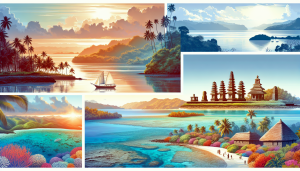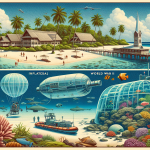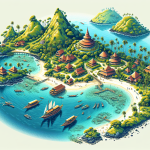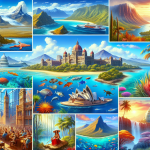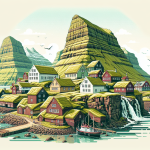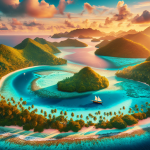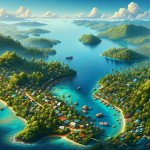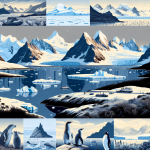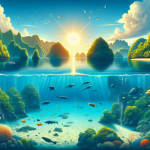Discovering Micronesia: An Uncharted Paradise
Micronesia, a subregion of Oceania, comprises thousands of small islands scattered across the western Pacific Ocean. This area, rich with cultural history and natural beauty, remains one of the world’s best-kept secrets. When people think of tropical paradises, they often envision places like Fiji or Bali, but Micronesia offers equally breathtaking landscapes, vibrant marine life, and unique cultural experiences that are relatively unexplored. This makes Micronesia an ideal destination for travelers seeking adventure away from the typical tourist routes. In this article, we’ll dive deep into the wonders of Micronesia, from its historical landmarks and pristine beaches to its diverse cultures and underwater wonders. So, pack your bags and get ready to explore this hidden gem in the Pacific.
Geographical Wonders of Micronesia
Micronesia covers a vast expanse of the Pacific Ocean, comprising four main archipelagos: the Caroline Islands, the Gilbert Islands, the Mariana Islands, and the Marshall Islands. Each of these island groups boasts its own unique attractions and natural beauty, making Micronesia a diverse and fascinating destination. The **Caroline Islands** are perhaps the most famous, home to the Federated States of Micronesia and Palau. The **Gilbert Islands** are part of the Republic of Kiribati, while the **Mariana Islands** include Guam and the Northern Mariana Islands. The **Marshall Islands** are known for their stunning atolls and rich marine life.
The Caroline Islands
The Caroline Islands are a treasure trove of natural beauty and cultural heritage. This archipelago, stretching over 1,800 kilometers, includes significant islands like Pohnpei, Chuuk, Yap, and Kosrae. **Pohnpei** is renowned for its lush rainforests, towering waterfalls, and ancient ruins, such as the mysterious **Nan Madol**, a series of more than 90 small artificial islands linked by canals. **Chuuk** is a diver’s paradise, famous for the **Chuuk Lagoon**, where WWII wrecks lie beneath crystal-clear waters, making it one of the world’s top wreck diving sites. **Yap** is known for its stone money and traditional culture, while **Kosrae** offers unspoiled natural beauty and excellent snorkeling opportunities.
The Gilbert Islands
The Gilbert Islands, part of the Republic of Kiribati, are known for their remote and pristine beauty. These islands boast some of the most untouched beaches in the Pacific, with white sands and turquoise waters. The capital, Tarawa, offers a glimpse into the local culture and history, with WWII relics and traditional thatched-roof houses. **Abemama**, another island in the Gilberts, is famous for its serene lagoons and vibrant marine life, making it a perfect spot for snorkeling and relaxation.
The Mariana Islands
The Mariana Islands, which include Guam and the Northern Mariana Islands, offer a blend of natural beauty and modern amenities. **Guam**, the largest island, is a popular destination for its luxury resorts, shopping, and historical sites such as the **War in the Pacific National Historical Park**. The **Northern Mariana Islands** are less developed but equally captivating, with islands like **Saipan**, **Tinian**, and **Rota** offering stunning beaches, WWII history, and opportunities for hiking and diving.
The Marshall Islands
The Marshall Islands are renowned for their atolls, which are ring-shaped coral reefs encircling lagoons. **Majuro**, the capital, is a bustling hub with a mix of modern and traditional elements. **Bikini Atoll**, a UNESCO World Heritage site, is famous for its nuclear testing history and now attracts divers eager to explore its underwater wrecks. The Marshall Islands also offer pristine beaches, excellent fishing, and vibrant local culture.
Cultural Richness of Micronesia
Micronesia’s cultural richness is as diverse as its geography. Each island group has its own unique traditions, languages, and customs, shaped by centuries of isolation and interaction with other cultures. Visitors to Micronesia can immerse themselves in local festivals, traditional dances, and craft-making, gaining a deeper understanding of the region’s heritage.
Traditional Practices and Festivals
In Micronesia, traditional practices and festivals play a vital role in the community’s social fabric. **Yap Day**, celebrated on March 1st, showcases Yapese culture through dance, music, and traditional sports. In **Chuuk**, the **Faichuk Festival** features canoe races, traditional dances, and local cuisine. The **Marshall Islands** celebrate **Manit Day** in September, highlighting their cultural heritage with performances, crafts, and traditional games. These festivals offer a unique opportunity for travelers to experience Micronesian culture firsthand.
Language and Craftsmanship
Micronesia is home to a rich tapestry of languages and craftsmanship. There are over a dozen languages spoken across the region, with each island group having its own distinct language and dialects. Traditional craftsmanship, such as weaving, carving, and canoe-building, is highly valued and passed down through generations. Visitors can explore local markets and workshops to see artisans at work and purchase unique handmade souvenirs.
Underwater Adventures in Micronesia
Micronesia is a diver’s paradise, offering some of the best diving and snorkeling spots in the world. The region’s clear waters, vibrant coral reefs, and diverse marine life make it an ideal destination for underwater enthusiasts.
Chuuk Lagoon
**Chuuk Lagoon** is one of the most famous diving destinations in Micronesia. This large lagoon, surrounded by a protective reef, is home to over 60 WWII shipwrecks, making it a premier wreck diving site. Divers can explore sunken warships, planes, and tanks, all teeming with marine life. The lagoon’s calm, clear waters provide excellent visibility, allowing divers to fully appreciate the underwater scenery.
Palau’s Rock Islands
**Palau**, part of the Caroline Islands, is renowned for its **Rock Islands**, a UNESCO World Heritage site consisting of over 200 limestone islands. The waters around the Rock Islands are home to some of the most diverse marine ecosystems in the world, with vibrant coral reefs, manta rays, and numerous fish species. Popular dive sites include **Blue Corner**, **German Channel**, and **Jellyfish Lake**, where visitors can swim among thousands of harmless jellyfish.
Bikini Atoll
**Bikini Atoll** in the Marshall Islands is another top diving destination, known for its history of nuclear testing and underwater wrecks. Divers can explore the sunken remains of warships and aircraft carriers, now transformed into artificial reefs teeming with marine life. The atoll’s remote location and limited access make it a unique and exclusive diving experience.
Sustainable Tourism in Micronesia
With its fragile ecosystems and unique cultural heritage, sustainable tourism is crucial for preserving Micronesia’s natural and cultural treasures. Travelers can play a vital role in supporting sustainable practices and protecting the environment.
Eco-Friendly Accommodations
Many islands in Micronesia offer eco-friendly accommodations that minimize their impact on the environment. These lodgings use sustainable practices such as solar power, rainwater collection, and waste recycling. By choosing eco-friendly accommodations, travelers can reduce their carbon footprint and support local conservation efforts.
Responsible Diving and Snorkeling
Divers and snorkelers can help protect Micronesia’s marine ecosystems by following responsible practices. This includes avoiding touching or damaging coral reefs, not disturbing marine life, and using reef-safe sunscreen. Many dive operators in Micronesia are committed to sustainable practices and offer eco-friendly diving options.
Supporting Local Communities
Travelers can also support sustainable tourism by engaging with local communities and contributing to the local economy. This can include purchasing locally-made souvenirs, dining at local restaurants, and participating in cultural tours and activities. By supporting local businesses, travelers help preserve Micronesia’s cultural heritage and promote sustainable development.
Practical Tips for Traveling to Micronesia
Traveling to Micronesia requires some planning, but the rewards are well worth the effort. Here are some practical tips to help you make the most of your trip.
Getting There
Micronesia is accessible by air, with international flights available to major islands such as Guam, Palau, and the Marshall Islands. From there, travelers can take regional flights to other islands in the region. It’s important to check visa requirements and travel advisories before planning your trip.
Best Time to Visit
The best time to visit Micronesia is during the dry season, which typically runs from November to April. During this time, the weather is more predictable, and there is less chance of rain. However, each island group has its own climate patterns, so it’s important to research the specific islands you plan to visit.
Health and Safety
Travelers should take standard health precautions, such as getting vaccinated and bringing any necessary medications. It’s also important to have travel insurance that covers medical emergencies. While Micronesia is generally safe, it’s always a good idea to stay informed about local conditions and follow safety guidelines.
Conclusion
Micronesia is a hidden gem in the Pacific, offering a unique blend of natural beauty, cultural richness, and underwater adventures. Whether you’re exploring ancient ruins, diving among WWII wrecks, or immersing yourself in local traditions, Micronesia promises an unforgettable experience. By embracing sustainable tourism practices, travelers can help preserve this uncharted paradise for future generations to enjoy. So, if you’re looking for a destination off the beaten path, Micronesia awaits.
For more information on traveling to Micronesia and planning your trip, visit Micronesia Travel.
